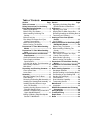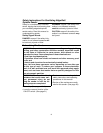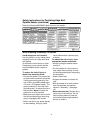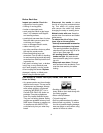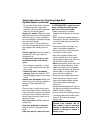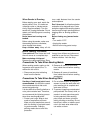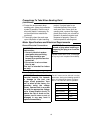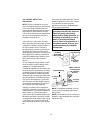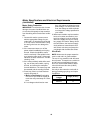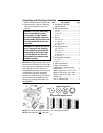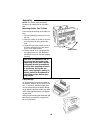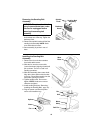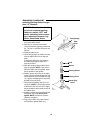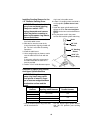
6
Safety Instructions for Oscillating Edge Belt/
Spindle Sander (continued)
• Do not wear loose clothing, gloves,
neckties or jewelry (rings, wrist
watches). They can get caught and
draw you into moving parts.
Know your sander. Read and under-
stand the owner’s manual and labels
affixed to the tool. Learn its applica-
tion and limitations as well as the spe-
cific potential hazards.
Plan your work. Think through how
you will hold and maneuver the work-
piece against the sanding drum or
belt.
Use the right tool. Don’t force tool or
attachment to do a job it was not
designed to do.
To reduce the risk of injury from
accidental contact with moving
parts:
• Do not layout, assemble, or setup
work on the sander while any parts
are moving.
• Reduce the risk of accidental
starting. Make sure switch is “OFF”
before plugging sander into a power
outlet.
Inspect your workpiece. Make sure
there are no nails or foreign objects in
the part of the workpiece to be
sanded.
Plan the way you will hold the work-
piece from start to finish. Reduce the
risk of awkward operations and hand
positions where a sudden slip could
cause finger or hand to move into a
sanding surface.
Don’t overreach. Maintain balance
and footing.
Keep face and body to one side.
Stay out of line of a possible throw-
back.
Plan your work to reduce the risk
of THROWBACKS - when the work-
piece catches the sanding drum
and is torn from your hands:
• Make sure there is no debris
between the workpiece and its sup-
ports.
• When sanding irregularly shaped
workpieces, plan your work support
so it will not slip and be pulled from
your hands.
• Use extra caution with large, very
small or awkward workpieces.
• Never use this tool to finish pieces
too small to hold by hand.
• Use extra supports (tables, saw
horses, blocks, etc.) for any work-
pieces large enough to tip when not
secured to the work surface.
• Never use another person as a sub-
stitute for a table extension, or as
additional support for a workpiece
that is longer or wider that the basic
sander table, or to help feed, sup-
port or pull the workpiece.
• Sand only one workpiece at a time.
• Clear everything except the work-
piece and related support devices
off the table before turning the
sander on.
• Always feed workpiece from right to
left against the direction the sanding
sleeve or belt is rotating.
• Do not use drums, sanding sleeves
or sanding belts which show visual
signs of wear such as grooves,
tears or rips.
WARNING: Don’t let familiarity
(gained from frequent use of
your sander) cause a careless
mistake. A careless fraction of a
second is enough to cause a
severe injury.




